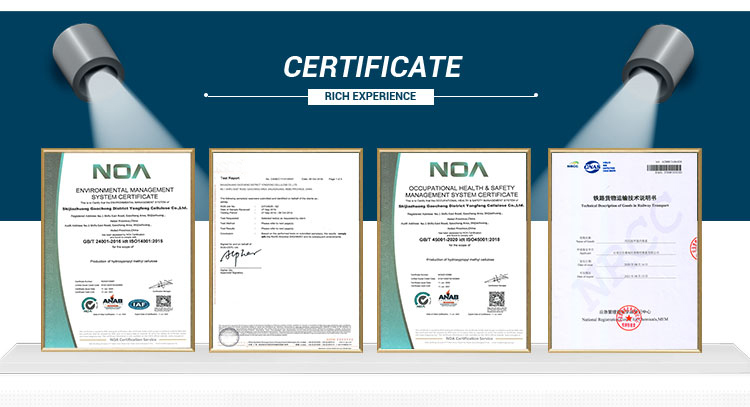The Versatility of Cellulose Material
Cellulose, a complex carbohydrate, is a critical component of the cell wall in plants, providing structural support and serving as an essential element in the fabric of nature. Composed of linear chains of β-D-glucose units linked together by glycosidic bonds, cellulose is the most abundant organic polymer on Earth. It plays a vital role not only in the natural ecosystem but also in various industrial applications. This article explores the properties, uses, and advantages of cellulose material, highlighting its significance in both ecological and economic contexts.
Properties of Cellulose
Cellulose is characterized by its high tensile strength and insolubility in water, which makes it an excellent structural material. Its crystalline structure results in stability and resistance to enzymatic degradation, attributes that enable it to survive in various environments. Additionally, cellulose has excellent absorption properties, allowing it to retain moisture while remaining dry to the touch.
One of the most remarkable features of cellulose is its biodegradability. As a natural polymer, cellulose can decompose through microbial action, returning to the environment without leaving harmful residues. This property positions cellulose as a sustainable alternative to synthetic materials that are prevalent in today's disposable culture.
Uses of Cellulose Material
1. Textiles and Apparel Cellulose is the primary component of fibers such as cotton, linen, and rayon. Cotton, derived from the cotton plant, is revered for its softness, breathability, and versatility in the textile industry. Rayon, a semi-synthetic fiber made from regenerated cellulose, mimics the feel of silk and is used in various clothing applications.
2. Paper Production The paper industry heavily relies on cellulose, primarily derived from wood pulp. Cellulose fibers provide the necessary strength and durability for paper products, making them suitable for everything from books and newspapers to packaging materials. The advent of digital media has impacted paper consumption, but the demand for sustainable paper products is driving innovation in eco-friendly alternatives.
3. Food Industry Cellulose is utilized as a food additive, functioning as a stabilizer, thickener, and anti-caking agent in various food products. Its insulative properties also play a role in reducing food spoilage. Moreover, more recent innovations have explored cellulose-based food packaging, which reduces plastic waste and enhances food preservation.
cellulose material

4. Pharmaceutical Applications In the pharmaceutical industry, cellulose serves multiple functions. It is used as an excipient in tablets, providing bulk and aiding in drug release. Microcrystalline cellulose, a refined form of cellulose, is particularly valued for its binding properties, ensuring the integrity of the tablet formulation.
5. Biocomposites and Nanomaterials Advances in material science have opened new avenues for cellulose use. Researchers are exploring cellulose nanofibers and cellulose nanocrystals for incorporation into biocomposites. These materials exhibit high specific strength and stiffness, making them ideal for applications in automotive, aerospace, and construction industries.
Advantages of Cellulose Material
The advantages of cellulose material extend beyond its inherent properties. As a renewable resource, cellulose can be sourced sustainably from plants, ensuring minimal environmental impact. Its biodegradability and non-toxicity make it a preferred choice for manufacturers seeking to reduce their ecological footprint.
Additionally, cellulose is a versatile material that can be processed and modified to suit a wide range of applications. Its adaptability means it can be engineered into various forms, such as films, gels, and fibers, catering to the specific needs of different industries.
Furthermore, the global push toward sustainability and circular economy principles has inspired a renewed interest in cellulose-based materials. As more companies and consumers seek eco-friendly products, cellulose stands out as a material that aligns with these environmental values.
Conclusion
In conclusion, cellulose material serves as a pillar of both nature and industry, showcasing the intersection of ecological integrity and economic utility. From textiles and paper to food and pharmaceuticals, its versatility is unmatched. As we move towards a more sustainable future, the importance of cellulose will undoubtedly continue to grow, influencing innovations that marry functionality with environmental stewardship. Embracing cellulose not only helps us preserve the planet but also opens doors to exciting new possibilities in material science and engineering.
-
Rdp Powder: Key Considerations for Wholesalers in the Building Materials IndustryNewsJul.08,2025
-
Key Considerations for Wholesalers: Navigating the World of Hpmc - Based ProductsNewsJul.08,2025
-
Hpmc Detergent: Key Considerations for WholesalersNewsJul.08,2025
-
Key Considerations for Wholesalers: China Hpmc For Tile Adhesive, Coating Additives, Concrete Additives, and MoreNewsJul.08,2025
-
Crucial Considerations for Wholesalers: Navigating the World of Construction MaterialsNewsJul.08,2025
-
Key Considerations for Wholesalers Sourcing Additive For Cement, Additive For Concrete, Additive For Putty from Additive Manufacturer Shijiazhuang Gaocheng District Yongfeng Cellulose Co., Ltd.NewsJul.08,2025




